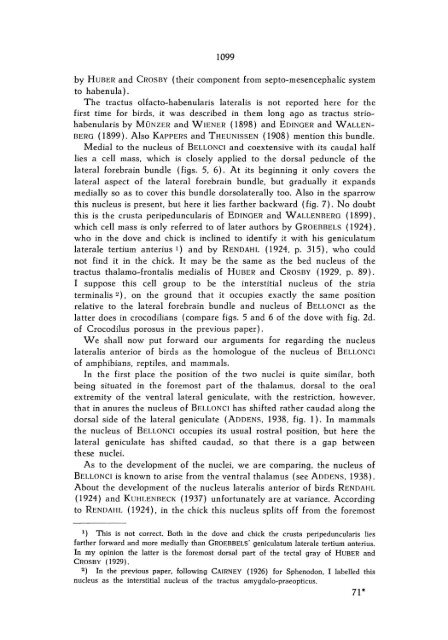The nucleus of BELLONCI in birds - DWC
The nucleus of BELLONCI in birds - DWC
The nucleus of BELLONCI in birds - DWC
Create successful ePaper yourself
Turn your PDF publications into a flip-book with our unique Google optimized e-Paper software.
1099<br />
by H UBER and CROSBY (their component from septo-mesencephalic system<br />
to habenula).<br />
<strong>The</strong> tractus oHacto-habenularis lateralis is not reported here for thc<br />
first time for <strong>birds</strong>, it was described <strong>in</strong> them long ago as tractus striohabenularis<br />
by MÜNzER and WIENER (1898) and EDINGER and W ALLEN<br />
BERG (1899). Also KAPPERS and THEUNISSEN (1908) mention th is bundIe.<br />
Medial to the <strong>nucleus</strong> <strong>of</strong> <strong>BELLONCI</strong> and coextensive with its caudal haH<br />
lies a cell mass, which is closely applied to the dorsal peduncle <strong>of</strong> the<br />
lateral forebra<strong>in</strong> bundIe (figs. 5, 6). At its beg <strong>in</strong>n<strong>in</strong>g it only covers the<br />
lateral aspect <strong>of</strong> the lateral forebra<strong>in</strong> bundIe, but gradually it expands<br />
medially so as to cover this bundIe dorsolaterally too. Also <strong>in</strong> the sparrow<br />
this <strong>nucleus</strong> is present, but here it lies farther backward (fig. 7). No doubt<br />
this is the crusta peripeduncularis <strong>of</strong> EDrNGER and W .ALLENI3ERG (1899),<br />
which cell mass is only referred to <strong>of</strong> later authors by GROERBELS (1924),<br />
who <strong>in</strong> the dove and chick is <strong>in</strong>cl<strong>in</strong>ed to identify it with his geniculatum<br />
laterale tertium anterius 1) and by RENDAHL (1924, p. 315), who could<br />
not f<strong>in</strong>d it <strong>in</strong> the chick. It may be the same as the bed <strong>nucleus</strong> <strong>of</strong> the<br />
tractus thalamo-frontalis medialis <strong>of</strong> HUBER and CROSBY (1929, p. 89).<br />
I suppose this cell group to be the <strong>in</strong>terstitial <strong>nucleus</strong> <strong>of</strong> the stria<br />
term<strong>in</strong>alis 2), on the ground that it occupies exactly the same position<br />
relative to the lateral forebra<strong>in</strong> bundIe and <strong>nucleus</strong> <strong>of</strong> <strong>BELLONCI</strong> as the<br />
latter does <strong>in</strong> crocodilians (compare figs. 5 and 6 <strong>of</strong> the dove with fig. 2d.<br />
<strong>of</strong> Crocodilus porosus <strong>in</strong> the previous paper).<br />
We shall now put forward our arguments for regard<strong>in</strong>g the <strong>nucleus</strong><br />
lateralis anterior <strong>of</strong> <strong>birds</strong> as the homologue <strong>of</strong> the <strong>nucleus</strong> <strong>of</strong> <strong>BELLONCI</strong><br />
<strong>of</strong> amphibians, reptiles, and mammals.<br />
In the first place the position <strong>of</strong> the two nuclei is quite similar, both<br />
be<strong>in</strong>g situated <strong>in</strong> the foremost part <strong>of</strong> the thalamus, dorsal to the oral<br />
extremity <strong>of</strong> the ventral lateral geniculate, with the restriction, however,<br />
that <strong>in</strong> anures the <strong>nucleus</strong> <strong>of</strong> <strong>BELLONCI</strong> has shifted rather caudad along the<br />
dorsal side <strong>of</strong> the lateral geniculate (AODENS, 1938, fig. 1). In mammals<br />
the <strong>nucleus</strong> <strong>of</strong> <strong>BELLONCI</strong> occupies its usu al rostral position, hut here the<br />
lateral genicuJate has shifted caudad, so that there is a gap between<br />
these nuclei.<br />
As to the development <strong>of</strong> the nuclei, we are compar<strong>in</strong>g, the <strong>nucleus</strong> <strong>of</strong><br />
<strong>BELLONCI</strong> is known to arise from the ventral thalamus (see ADDENS, 1938).<br />
About the development <strong>of</strong> the <strong>nucleus</strong> lateralis anterior <strong>of</strong> <strong>birds</strong> RENDAHL<br />
(1924) and KUHLENHECJ( (1937) unfortunately are at variance. Accord<strong>in</strong>g<br />
to RENDAHL (1924), <strong>in</strong> the chick this <strong>nucleus</strong> splits oH from the foremost<br />
1) This is not correct. Both <strong>in</strong> the dove and chick the crusta peripeduncularis lies<br />
farther forward and more medially than GROEBBELS' geniculatum laterale tertium anterius.<br />
In my op<strong>in</strong>ion the latter is the foremost dorsal part <strong>of</strong> the tectal gray <strong>of</strong> HUB'ER and<br />
CROSBY (1929).<br />
2) In the previous paper, follow<strong>in</strong>g CAIRNEY (1926) for Sphenodon, I labelled th is<br />
<strong>nucleus</strong> as the <strong>in</strong>terstitial <strong>nucleus</strong> <strong>of</strong> the tractus amygdalo-praeopticus.<br />
71*
















